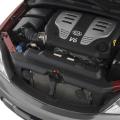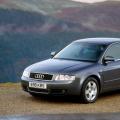Audi (Audi), a German company specializing in the production of passenger cars. Part of the Volkswagen concern. The headquarters is in Ingoldstadt.
The Audi company was founded in 1909 by August Horch. Its roots go back to the now defunct, but no less famous in the past company Horch ("Horch"), which shone in the German horizon during the Third Reich. In 1899, the talented inventor August Horch founded Horch and Company in Mannheim, which moved to Zwickau four years later. In 1909, he built a very unsuccessful new 6-cylinder engine, which almost brought the company to the brink of bankruptcy, which greatly angered his partners, who decided to crack down on the zealous inventor and expel him from their own company. But Horch immediately founded another company nearby, which, of course, also bore the name Horch. His former partners, sensing a strong competitor in the young firm, filed a lawsuit against Horch demanding to change the name of the firm. According to the court's decision, the new car manufacturing enterprise could not bear the name Horch, and August Horch turned to the Latinized version of the former name: the word horch, meaning “listen” in German, became audi. So in 1909 the famous trade mark and no less famous company "Audi" was born.
The first car called Audi-A was produced in 1910. The Audi-B model followed the next year. Horch exhibited three of these cars in June 1911 at the first Auto Alpenfart races in the Austrian Alps, about 2500 km long, which replaced the famous races for the prize of the German Prince Heinrich.
In 1912, the most famous model appeared - the Audi-S. In the same year, its first samples passed a serious test at the next Alpine races and achieved good results, for which the cars of the C series began to be called "Alpenziger" or "Conqueror of the Alps".
In the 1920s, Audi was on the brink of bankruptcy. She had to merge with another firm.
In 1928 the company was acquired by the German DKW (DKW), and Jorgen Skafte Rasmussen became the owner of Audi.
In 1932, the economic crisis prompted a number of German firms to create the Auto Union concern ("Auto Union"). It includes, along with DKW and Wanderer ("Wanderer") former rival firms Horch and Audi. The concern released two models equipped with front-wheel drive and Wanderer engines. The cars sold well until the outbreak of World War II.
After World War II, Audi and other Auto Union partner firms were nationalized. They were transformed into a division of the Association of People's Enterprises for the Production of Cars.
In 1949, Auto Union was reformed by attracting a majority of the shares of Mercedes-Benz (Mercedes-Benz).
In 1958, Daimler-Benz AG acquired a controlling stake in Auto Union, but then sold them to Volkswagen. After the transfer in 1965 of a controlling stake to Volkswagen ("Volkswagen"), the name Audi was again used. Shortly after this event, a new front-wheel drive car was launched, and by the end of 1968 Audi was back on the market with a good range of models and excellent sales statistics. Four circles have been retained as the emblem, symbolizing the merger of the four companies in 1932.
The "100", which entered the market in 1968, and its successors, including the famous Audi Quattro, featured a sporty profile and four-wheel drive, which was a new milestone in the German automotive industry. It was the Quattro model, which appeared in 1980, that gave a powerful impetus to the development of the automotive industry and brought Audi, a Volkswagen subsidiary, worldwide fame. It was a light, fast Gran Turismo with excellent stability, a type of rally car. It was difficult for competitors to compete with this rally Quattro. The model has performed exceptionally well in several auto races.
In 1969, Volkswagen bought the Neckarsulmer Automobilwerke (NSU Automobile Plant in Neckarsulm). As a result, the name of the company changed, the company became known as Audi NSU Auto Union, and in the summer of 1985 the name of the company was transformed again into Audi AG.
Since 1970, extensive export of Audi to the United States began. At first, exports to the US were limited to the Audi Super 90 (sedan and station wagon). as well as the new Audi 100.Since 1973 they were joined by the Audi 80. which, unlike the European version, existed as an Audi 80 station wagon (in fact, a VW Passat Variant with a higher equipment level). Later, Audi models received their own designations in the US market: Audi 4000 for the Audi 80. Audi 5000 for the Audi 100. However, repeated cases of manufacturer liability violations for their products since the mid-1980s led to a decline in Audi shipments to the USA.
In 1980, the all-wheel drive sports coupe attracted huge attention at the Audi stand at the Geneva Motor Show. For the first time, an all-wheel-drive, high-performance light vehicle was offered as an Audi quattro with an all-wheel drive concept, which until now has only been used in trucks and SUVs. The idea of \u200b\u200bsuch a passenger car arose in the winter of 1976/77 during test drives on the VW Iltis SUV being developed for the Bundeswehr. The excellent behavior of this car when driving on ice and snow led to the idea of \u200b\u200bintroducing the VW Iltis all-wheel drive in the serial Audi 80. An increased power option was also developed - a five-cylinder 2.2 liter turbo engine with 147 kW / 200 hp, presented in autumn 1979. from.
In 1982, the Audi 80 quattro launched the large-scale production of permanent all-wheel drive. Gradually, the quattro concept was also offered for other Audi model series.
On the basis of the Audi 80, a sports coupe (Audi Coupe) was produced, which debuted at the end of 1993. The cabriolet version was first presented in Geneva in 1991. This veteran of the Audi family was discontinued in mid-2000. Since 1992, they have produced about 72 thousand pieces.
In December 1990, the new Audi 100 (internal designation C4) was presented, which for the first time in the company's history was also offered with a V-shaped six-cylinder engine. The compact (128 kW. 174 hp) powerful unit with a displacement of 2.8 liters was the shortest and lightest in its class.
The Audi A4 is the successor to the Audi 80 from 1986-1994. It was first introduced in October 1994.
In 2001, the A4 Avant station wagon and the A4 Cabrio coupe-cabriolet were released, which will receive a folding hard top (like the Mercedes-Benz SLK) and, obviously, will be assembled at the Karmann plant.
Audi A8 flagship of the Audi lineup was first shown in February 1994
In May 1994, the public was presented with a five-seater RS2 Avant with a 2.2-liter 315-horsepower turbo-injection engine.
The Audi A3 is based on the Golf IV platform. The first show of the model took place in June 1996. Production of the Audi A3 began in 1997.
The Audi A6 was first introduced as a sedan at the Geneva Motor Show in 1997. In February 1998, the A6 Avant was introduced with a station wagon. All models of the C4 platform were discontinued in the summer of 1997 in connection with the development of the completely new A6 (4B-type).
From the moment the concept Audi A2 was shown in the fall of 1997, to the start of serial production (early 2000) of the A2 model, a little more than two years passed. This is how Audi has a new family of passenger cars in the European size class B.
AUDI S4 / S4 Avante / RS4, high-performance sports modification of the Audi A4 with 2.7-V6-Biturbo engine. It was first presented at the Frankfurt Motor Show in 1997. In 1999, a modification of the RS4 Avante with a 2.7-V6-Biturbo engine (380 hp) was presented.
In the fall of 1996, the "sports" configurations S6 / S6 Avant appeared.
The Audi TT sports car with a coupe body was first presented in Geneva in September 1998, with a roadster body in August 1999. The prototype model was presented at the 1995 Frankfurt Motor Show.
AUDI S3, a sports modification of the Audi A3 with a 1.8 20V turbocharged engine and an all-wheel drive transmission with high power. It was first introduced in March 1999.
AUDI S8, high performance sports version of the Audi A8 with 4.2 V8 engine and all-wheel drive. It was first shown in early 1998.
The Audi Allroad, an off-road model based on the A6 Avant, was first introduced in February 2000.
Currently, Audi, which is part of the Volkswagen Group, is experiencing a boom. Such success became possible thanks to new developments of the company.
The first generation Audi A4 was produced from 1994 to 2001. Four-cylinder engines 1.6 and 1.8 developed power from 101 to 170 forces. Two years after the release, a station wagon and an all-wheel drive version of the A4 quattro appeared, at the top of the range a version with a "biturbo-six" 2.7 with a capacity of 265 liters was fixed. from. More than 30 thousand such cars were sold.
The model was equipped with a five- and six-speed manual transmission or a four- or five-speed automatic transmission.
2nd generation, 2000-2006

The second generation Audi A4 with the B6 index was produced from 2000 to 2006. The car was equipped with a three-liter engine that develops a power of 220 liters. from. The car was offered with five- and six-speed "mechanics" and "automatic". The car was produced in several versions: a four-door sedan, a five-door station wagon, a two-door convertible.
3rd generation, 2004-2008

The "third" Audi A4 with the B7 index, produced from 2004 to 2008, can be called the result of restyling of the previous model. Five gasoline engines (the most powerful "six" 3.2 developed 255 hp) had the same number of diesel engines. At the top of the gamut was a 420-horsepower modification, equipped with an atmospheric "eight" 4.2 with direct injection.
The car was offered with a five- and six-speed "mechanics", a six-speed ZF tiptronic and a seven-speed multitronic.
In 2008, a sedan and a station wagon were created on the basis of this model.
4th generation, 2008–2015

The fourth generation Audi A4 has been produced in Germany since 2008. At the end of 2011, the model underwent restyling. In 2009–2010, screwdriver assembly of machines for the Russian market was carried out at a plant in Kaluga. The charged versions of the car were called and.
The cars were equipped with turbocharged engines, gasoline and diesel, with a volume of 1.8, 2.0 and 3.0 liters. Drive - front or full. Transmission - "mechanics", CVT or robotic preselective gearbox.
Prices for the model in the most affordable version in Russia started from 1,480,000 rubles. In 2015, a generational change took place.
The company "Audi" is best known as a manufacturer of executive business sedans or charged cars. But Audi station wagons also have their own audience. The charged Avant, S7 and other models are very expensive and combine a spacious family car and sporty power. How did the history of the Audi station wagon lineup begin? Read about this in this article.
"Audi-80"
The Audi-80 model was produced by the company from 1966 to 1996. The station wagon was produced from the second generation, starting with the B1. In 1973, the model appeared in Europe as a coupe, sedan and 5-door station wagon.
The car was equipped with three engine options - 1.3-liter, 1.5-liter and 1.6-liter. In 1976, the company restyled the model and released a modified body. Restyling affected the headlights, the front of the car. The optics became square and took on a more modern look, which was vaguely similar to the current generation of Audi. The model also became more powerful: the 1.5-liter engine was replaced by a 1.6-liter with 85 horsepower.
In 1984, the model was transferred to the B2 platform. In this generation, there were no Audi station wagons. The 80 was produced in sedan and coupe versions.
"Audi-100"
This model from 1968 to 1994 was the flagship for "Audi", right up to the change of the lineup.
The car had features of more modern models. Since 1985, all bodies for 100 Audi began to be made of galvanized metal, in contrast to the Audi-80 station wagon model. This car had the best aerodynamic coefficient in its class at that time. The car was equipped with the following units: 1.8-liter with 90 horses under the hood, 2-liter engine with 136 horsepower, 2.5 liters with 120 horsepower.
Production of the "Audi-100" station wagon (Avant) was discontinued in 1994. Since then, Audi has revised its view of the lineup and introduced a new line.

New lineup
Since 1994, a new era has begun for Audi. The first car was the A6 line, which was previously called the "Audi C4" wagon.
From that moment on, all Audi cars received an index with the letter A and a number (A3, A4, A6, and so on). Station wagons still appeared in only two versions - A4 and A6 with the Avant prefix.
The first generation can be called the usual restyling of the Audi-100. The A4 model appeared a little later. The bodies of this car received the index B. These are all station wagons in the model range of the German concern. Next, we will talk about the last generations of two station wagons.
"Audi A4 B9"
In 2016, the A4 series received an update. The fifth generation in the back of the B9 is planned to be produced until 2017. Let's take a closer look at the appearance and characteristics of the station wagon. "Audi A4" station wagon began to be produced simultaneously with the sedan. The new body has changed not so much externally as in terms of technology. The optics remained almost the same, the creators changed the usual lighting to LED headlights. Overall, the Avant looks even sportier and more aggressive. Especially in red. The front bumper with "evil" air intakes on the sides, an aggressive line of headlights and a squat roof - all these details are peculiar only to station wagons from "Audi".
Inside the car is the realm of modern technology. All the developments that Audi has today, the company has added to this car. Here you will find virtual appliances, wireless charging. The multimedia display has been replaced with a new 8-inch screen with a rich picture. It is stupid to focus on the quality of materials and workmanship - the German car industry has always been distinguished by great attention to detail and comfort.

After all, we are considering a family car, which means we need to talk about dimensions and roominess. "Audi A4" station wagon has become larger than its predecessor. In length, the model reaches 4725 mm, its width is 1842 mm, and its height is 1840 mm. Despite the fact that the car outwardly seems too stocky and impetuous, it is quite tall in size.
The trunk with the rear seats in use is small - 505 liters. If you fold the back row, you can get 1000 liters more. It is not crowded inside the cabin, but it is better not to travel long distances with a large family or company. For this purpose, the older model is better suited, which will be discussed below.
One of the following engines can be located under the hood of the station wagon: 1.4 liters for 150 horsepower, 2 liters for 190 horsepower and two similar units on diesel fuel. The Audi A4 station wagons are available in two trim levels - Design and Sport. The cheapest option with a 1.4-liter engine and a Design package will cost the car owner about 1 million 950 thousand rubles. For the richest configuration with a powerful 2-liter engine, you will have to pay more than 2,300,000 rubles.
A4 wagon verdict
This car is perfect for a small family. In addition, it can be used as a business car and for work. Also, the car perfectly performs the function of a weekend transport. The driver can enjoy the ride thanks to the powerful motor and precise handling of the station wagon.

"Audi A6" station wagon
A6 is an adult and serious car. This is proved by the whole appearance of the machine. The model is available in sedan and station wagon bodies. Those who are not familiar with Audi products are unlikely to distinguish the A4 and A6 station wagons. However, there are differences here.
First, the A6 is a business class. Accordingly, everything in it is done at a higher quality and more expensive level. For each owner, it is possible to create a unique package that will meet all the necessary needs. The car was restyled in 2014. In this form, the car is produced to this day.
Since each customer can supply his own configuration with the options he needs, the Audi A6 station wagon does not have fixed sets of options.

The car is sold with one of three engines to choose from: a 1.8-liter with 190 horsepower, a 2-liter with 250 horsepower and a charged 3-liter with 333 "horses" under the hood. All options are petrol. The 1.8 liter engine is equipped with either a manual or automatic gearbox. More powerful options are paired with an automatic transmission.
Recent generations have received accolades and high marks for safety. Even without additional options, the car cannot be called poor in terms of equipment. The trunk of the car is slightly larger than in the A4 station wagon - 565 liters with the rear seats unfolded and 1680 with the rear seats folded.
The cheapest version of a station wagon with a 1.8 liter engine and a manual transmission will cost 2 million 600 thousand rubles. The richest equipment with a powerful 3-liter engine will cost a little more than 3 million 600 thousand rubles.

Outcome
The Audi station wagons are a combination of an executive class and a family car. At the same time, the Germans make this combination extremely balanced, so it is difficult to evaluate a car in one specific category. Both cars can be used for daily business trips, family vacations. At the same time, "Audi" can "ignite" on the asphalt and bring a lot of emotions and driving pleasure.
1899
Timeline of Audi 1899
August Herch founded the automobile company "Horch & Cie. Motorwagen Werk" in Cologne.
1904
Chronology of a 1904 Audi
Horch & Cie. Motorwagen Werke reorganized into a joint stock company.
1909
Chronology of a 1909 Audi
After leaving "Horch & Cie. Motorwagen Werke" A. Horch founded the new company "Audi Automobilwerke GmbH".
1931
Timeline of Audi 1931
Debut of the world's first front-wheel drive vehicle, the "DKW F1".
1932
Timeline of Audi 1932
The merger of Audi, DKW, Horch and Wanderer took place to form Auto Union GmbH.
1950
Timeline of a 1950 Audi
The first post-war passenger car of the concern - "DKW F89 P Master Class" appeared.
1964
Timeline of a 1964 Audi
Auto Union AG became part of the Volkswagen AG concern.
1965
Timeline of Audi 1965
It was decided to release all new models of the concern that lost its independence under the Audi brand.
1968
Timeline of Audi 1968
Under the conditions of secrecy from "Volksvagen", a middle class car - "Audi 100" was developed.
1969
Timeline of a 1969 Audi
Merger of Auto Union GmbH with NSU Motorenwerke AG.
1972
Timeline of a 1972 Audi
The first generation of the production car "Audi 80" (B1 series) was designed and produced.
1976
Timeline of a 1976 Audi
Audi develops its first five-cylinder engine.
1977
Timeline of a 1977 Audi
Launch of the latest NSU products and the start of production under the Audi brand
1979
1979 Audi chronology
Developed turbocharging technology for engines.
1980
Timeline of a 1980 Audi
For the first time Audi is introducing a permanent all-wheel drive system - the Quattro trademark.
1985
Timeline of Audi 1985
Audi NSU Auto Union AG changed its name to AUDI AG.
1990
Timeline of Audi 1990
Introduced the new "Audi 100" (C4) - also available for the first time with a compact 2.8L V6 engine with 174 hp.
1994
1994 Audi chronology
For the first time presented the flagship of the company's lineup - the Audi A8
1994
1994 Audi chronology
On the basis of "Audi 100" there was a business class car - sedan "Audi A6"
1996
Timeline of Audi 1996
The Audi lineup has been expanded with a golf-class model - the compact Audi A3.
1996
Timeline of Audi 1996
The 1991 Audi 80 (B4) was replaced by the Audi A4 medium-sized C-class model.
1998
Timeline of Audi 1998
The appearance of a serial sports coupé with an attractive appearance - "Audi TT".
1998
On the basis of the station wagon "Audi A6 Avant", the all-wheel drive crossover "Audi Allroad Quattro" was created.




